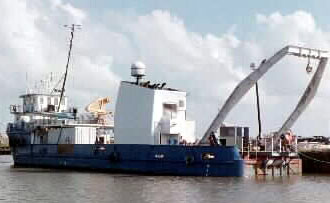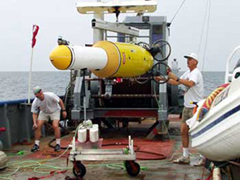Fresh out of the shipyard and enroute to Trinidad for a surface geochemical exploration and heat flow consortium program, the R/V JW Powell was diverted to St Petersburg Florida to conduct a 8 day R&D effort directed at enhancing homeland security. John Kloske (University of South Florida, College of Marine Science Center for Ocean Technology, marops@seas.marine.usf.edu) has been funded by the Office of Naval Research since August 2002 on four research projects totalling nearly $2 million for development, testing and evaluation of an Autonomous Unmanned Vehicle (AUV) and Mobile Inspection Platform with specific applications to Homeland Defense in securing the nation’s ports and harbors. Development of these and similar tools are one of the key elements critical to implementation of the new Maritime Security Laws and Regulations (for example, see www.unitel.com/maritime.html).
|
The R/V JW Powell
|
|
The work opportunity for the Powell came suddenly, when one of the USF vessels previously used on the project became unavailable. TDI-Brooks International responded to the very short fused RFP (7 days from announcement to bid opening), delaying the exploration consortium program slightly to fit the priority project in. Not only was the Powell found to be the best suited vessel to respond to the RFP, but the Powell was the most attractive in price, even when mobilized from Freeport Texas.
Features which made the Powell ideal for Kloske’s cruise included:
|
|
| Despite the diversity and range of Kloske’s requirements, the Powell remained fully rigged and equipped for the dual objective exploratory cruise which followed in Trinidad.
The cruise plan called for anchoring at the St. Pete Beach Artificial reef site (comprised of 10 sunk army battle tanks) while the AUV and ROV was deployed to find, identify and characterize features which would be considered a threat to shipping and national security. Eight days were spent on site, with near perfect weather. |
This is not the first time the R/V JW Powell has had a high profile role involving security of the country. The JW Powell’s (under a different name, and for sure under different ownership!) first claim to fame came in the late 1970’s when the vessel was seized by the US Coast Guard under machine gun fire on a night time high seas chase that resulted in the largest (as of that date) drug bust in US history. USGS subsequently acquired the vessel for use in their research programs. USGS significantly improved and modified the Powell’s original configuration and facilities, and then made the vessel available to a number of charterers including The Harbor Branch Oceanographic Institution, and Texas A&M University.
In 1989 the Powell was featured in the James Bond spy thriller “License to Kill” (www.imdb.com/title/tt0097742/), which starred Timothy Dalton, Carey Lowell, and Wayne Newton. Extreme cinematographic liberty was taken in depicting the interior accommodations of the vessel, but the Powell is clearly recognizable in outboard profile and scenes shot in the bridge. TDI-Brooks acquired the JW Powell as it’s second research vessel in June 2000, and operates it primarily in Africa, the Caribbean, South America and the Gulf of Mexico.




